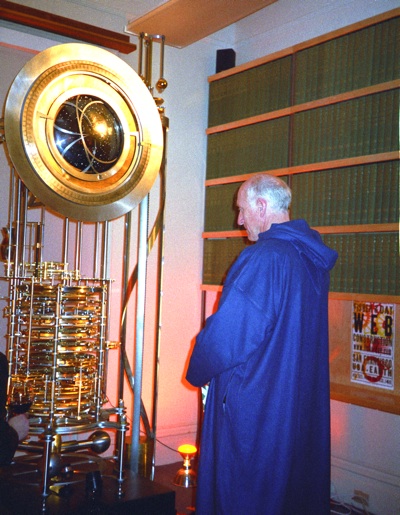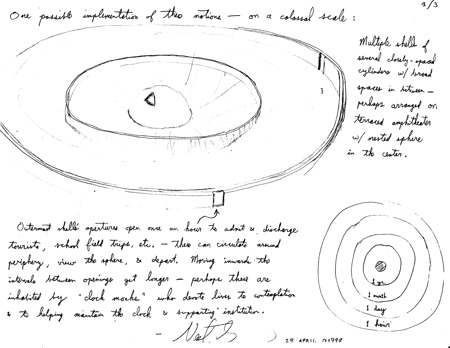Music For Monks, Mathematicians And Millennia
Music, reality and science-fiction are moving into alignment once more. Continuing in a similar vein to the 639-year concert in Halberstadt, we now introduce a 10,000 year clock and an album of acapella music by futuristic alien monks, courtesy of Neal Stephenson and the Long Now Foundation…
How Long Is Now?
The Long Now Foundation was born in 1996, the name coined by Brian Eno, one of the founders. Similar to the principles behind John Cage’s ASLSP composition, the Foundation seeks to expand our consideration and understanding of what constitutes now, acting as a sort of counterbalance to the increasing speed and fragmentation of modern life.

As part of this initiative, the Foundation created a 10,000-year clock prototype, the full version of which they plan to install within a mountain, accessed by a long vertical tunnel.
The inspiration for the clock came from Daniel Hillis:
“When I was a child, people used to talk about what would happen by the year 2000. For the next thirty years they kept talking about what would happen by the year 2000, and now no one mentions a future date at all. The future has been shrinking by one year per year for my entire life. I think it is time for us to start a long-term project that gets people thinking past the mental barrier of an ever-shortening future. I would like to propose a large (think Stonehenge) mechanical clock, powered by seasonal temperature changes. It ticks once a year, bongs once a century, and the cuckoo comes out every millennium.”
Stephenson’s Time Engine
The clock prototype was completed before the turn of the millennium, and Kevin Kelly recalls the occasion of its first millenial chime – the clock is designed to bong once a century, and once for a millennium, providing a grand total of two chimes on the thousand year mark.

In 1998, Daniel Hillis asked Neal Stephenson to provide suggestions as to what a 10,000 year clock might look like. Stephenson drew some sketches of a giant structure of concentric circles, which would rotate to open passages at predetermined intervals, allowing people through.
This clock concept was expanded and is now a central component of Neal’s forthcoming novel, Anathem. The novel is inhabited by Mathic Monks who safeguard their world’s knowledge within the confines of the clock compound, having a vastly different sense of time, principles and priorities to those on the outside, the “extramuros”.
The Music Of Anathem
Anathem will be released next month, but in addition to the book, there is also a CD of music created by David Stutz. This disc is an interpretation of what the music created by the avout might sound/have sounded/will have been going to sound like, and initial reactions proclaim it to be very weird shit indeed.
Here’s how Stutz describes his venture into the world of Anathem:
It was clear from day one that the characters and institutions found in the book possess many musical traditions, each forged over thousands of years of isolation, and each strangely similar to, yet exotically removed from, the monastic traditions of Earth. As an active performer of Earthly vocal music, as a lapsed musicologist, and especially as a composer, I was excited by the possibilities opened up by Neal’s imagination: somber music to celebrate the mysteries of philosophy and mathematics within the soaring stone walls of a mynster; simple songs to ease the mathematical drudgery encountered when verifying theories; inward meditations upon truth and beauty; and finally, fiendishly difficult musical games designed to hone intellectual prowess.
In a very neat circle-fulling move, all proceeds from the sale of the album will be donated to the Long Now Foundation.
Stutz’s Anathem page also features some scores not included on the album. On his Mascheroni Circles page, you will find a geometry proof that he turned into a musical puzzle for one or more players. One version (or realisation) of this ‘composition’ appears on the Anathem CD, and seems like a perfect fit for the epic and erudite detail of what should be another highly stimulating Neal Stephenson creation.